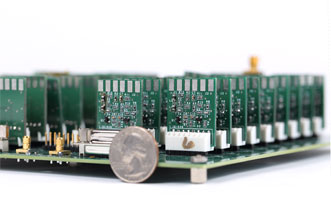A vibrational spectroscopic imaging technology that captures images of living cells could become an advanced medical diagnostic tool for the early detection of cancer and other diseases.
The electronic device is referred to as a 32-channel tuned amplifier array, or TAMP array, and was developed at Purdue University’s Jonathan Amy Facility for Chemical Instrumentation, which is part of the school’s Department of Chemistry. Approximately 1000 times faster than a state-of-the-art commercial Raman microscope, the device is already the subject of two patents.
High-speed spectroscopic imaging enables observation of rapidly changing metabolic processes inside living cells, as well as imaging of large areas of tissue, making it possible to scan an entire organ.

The 32-channel tuned amplifier array, or TAMP array, could aid early detection of cancer and other diseases through microsecond-speed vibrational spectroscopic imaging. Courtesy of Purdue University.
"For example, we will be able to image the esophagus or urinary bladder for diagnosis of tumors," said Ji-Xin Cheng, a professor at Purdue’s Weldon School of Biomedical Engineering. "If you were to take one millisecond per pixel, then it would take 10 minutes to obtain an image, and that's too slow to see what's happening in cells. Now we can take a complete scan in two seconds."
The technology represents a new way to use stimulated Raman scattering to perform microsecond-speed vibrational spectroscopic imaging, which can identify and track certain molecules by measuring their vibrational spectrum with a laser. In short, it provides a type of spectral fingerprint.
The imaging technique also is label-free, meaning it does not require samples to be marked with dyes. This aspect of the technology makes it appealing for diagnostic applications. An additional advantage is that this new system can be combined with flow cytometry to allow it to look at one million cells per second.
"You can look at large numbers of cells from a patient's blood sample to detect tumors, for example, and you can also look directly at organs with an endoscope," Cheng said. He added that "these capabilities will change how people use Raman spectroscopy for medicine. There are many organelles in each cell, and spectroscopy can tell us what's in the organelles, which is information not available by other techniques."
The findings were published in Light: Science & Applications (doi: 10.1038/lsa.2015.38).
For more information, visit www.purdue.edu.